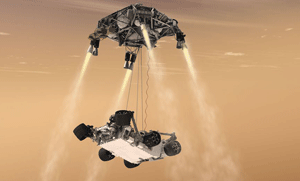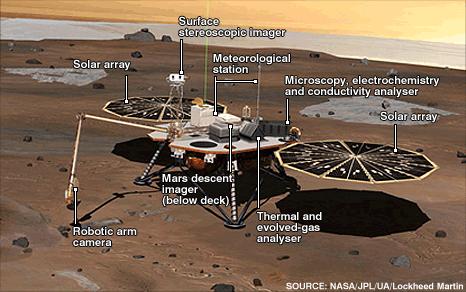Re Ian Bremmer 'Could third-party candidates upend the 2024 US election?' 3 April The current political movement in the USA…
Mars
Written by Diana Thebaud Nicholson // January 8, 2012 // Aviation & Aerospace, Science & Technology // 1 Comment
Exploring Mars
Historic pictures sent from Mars; space.com
Mars500 mock mission reveals dangers of long space flights
Flying all the way to Mars may not be as fun as it seems. Astronauts will get to travel at super-fast speeds, but they will probably suffer problems with fatigue and boredom as well as mental health issues that might jeopardize the mission.
These conclusions come from the Mars500 experiment, a joint effort between the Russian Academy of Sciences, the European Space Agency and the China National Space Administration that was conducted over 520 days in 2010 and 2011. The experiment put a six-man crew of astronauts in isolation to simulate a mission to Mars, recording their daily activity, as well as their physical and mental health.
2012
5 December
The Great Martian Mystery Revealed… Sort of
The finale of 2012’s Great Martian Mystery was finally on stage Monday at the American Geophysical Union conference in San Francisco. A panel of Mars Science Laboratory scientists were first up (AGU knew better than to keep the TV networks waiting; their collective attention spans would be rapidly exceeded). … We are dealing with the beginnings of what could end up being life, or pre-life, or at least simple organics on Mars. Add this to the recent (ca 2011) reinterpretation of the Viking experiments by Chris McKay at NASA’s Ames Research Center, which resulted in that normally-conservative scientist saying, for all to hear, “Contrary to 30 years of perceived wisdom, Viking did detect organic materials on Mars,” and you have a red-hot chili-pepper of an issue.
20 November
Mars Mystery: Has Curiosity Rover Made Big Discovery?
NASA’s Mars rover Curiosity has apparently made a discovery “for the history books,” but we’ll have to wait a few weeks to learn what the new Red Planet find may be, media reports suggest.
The discovery was made by Curiosity’s Sample Analysis at Mars instrument, NPR reported today (Nov. 20). SAM is the rover’s onboard chemistry lab, and it’s capable of identifying organic compounds — the carbon-containing building blocks of life as we know it.
SAM apparently spotted something interesting in a soil sample Curiosity’s huge robotic arm delivered to the instrument recently.
27 September
Mars rover finds first evidence of water: a river of it
(Reuters) – NASA’s Mars rover, Curiosity, dispatched to learn if the most Earth-like planet in the solar system was suitable for microbial life, has found clear evidence its landing site was once awash in water, a key ingredient for life, scientists said Thursday.
Scientists suspect the mound, known as Mount Sharp, is the remains of sediment that once completely filled the crater. Analysis of a slab of rock located between the crater’s north rim and the base of Mount Sharp indicate a fast-moving stream of water once flowed there.
NASA’s Mars rover lands safely on the Red Planet
Challenges of Getting to Mars: Curiosity’s Seven Minutes of Terror
“When we first get word that we’ve touched the top of the atmosphere, the vehicle has been alive or dead on the surface for at least seven minutes.”
Team members at NASA’s Jet Propulsion Laboratory share the challenges of the Curiosity Mars rover’s final minutes to landing on the surface of Mars.
7 August
The Financial Times emphasizes a very important aspect of Curiosity’s success Landing reignites interest in space — Nasa takes step towards restoring reputation for cosmic wizardry and recapturing public imagination after years of budget cuts and retrenchment
6 August
Mars rover Curiosity lands on surface of Red Planet
Aug 5 (Reuters) – The Mars science rover Curiosity landed on the Martian surface shortly after 10:30 p.m. Pacific time on Sunday (1:30 a.m. EDT Monday/0530 GMT) to begin a two-year mission seeking evidence the Red Planet once hosted ingredients for life, NASA said.
Mission controllers at the Jet Propulsion Laboratory near Los Angeles said they received signals relayed by a Martian orbiter confirming that the rover had survived a make-or-break descent and landing attempt to touch down as planned inside a vast impact crater. NASA has described the feat as perhaps the most complex ever in robotic spaceflight.
The $2.5 billion Curiosity project, formally called the Mars Science Laboratory, is NASA’s first astrobiology mission since the 1970s-era Viking probes. The landing, a major victory for a U.S. space agency beleaguered by budget cuts and the recent loss of its space shuttle program, was greeted with raucous applause and tears of joy by jubilant engineers and scientists at mission control.
Missions to Mars: Remembrance of probes past
(The Economist | Babbage) AT 5.32am co-ordinated universal (read: Earth) time on August 6th, staff at NASA’s Jet Propulsion Laboratory (JPL) in California broke out in wild cheers. Curiosity—the biggest, most sophisticated rover ever sent to Mars—had touched down successfully, its spectacularly complicated landing procedure going off without a hitch. The landing was a triumph of creative engineering, allowing the car-sized robot (one of whose wheels is visible in the picture above) to bring an unprecedented array of scientific tools to the Martian surface. In the “seven minutes of terror” it took Curiosity to descend from orbit, fingernails at JPL had been chewed back to the quick. According to Charles Bolden, NASA’s administrator, John Holdren, Barack Obama’s science advisor, was so worried that something would go wrong that he had almost been physically sick.
Dr Holdren had good reason to be concerned. Counting Curiosity, only 15 of the 41 missions that humans have sent to Mars have been successful.
3 August
Mission to Mars: Anticipating NASA Rover ‘Curiosity’ Touchdown
(PBS Newshour) NASA will soon attempt to land the rover Curiosity on the surface of Mars. If all goes as planned, Curiosity will enter the Martian atmosphere, slowing its descent by releasing a parachute, and lower to the surface on a tether with the help of a ‘sky crane.’ Miles O’Brien previews the anticipated rover landing on the Red Planet.
 Mars rover has a considerable Canadian connection
Mars rover has a considerable Canadian connection
Curiosity’s mission begins early on Aug. 6
(CBC) Not only are a number of Canadians piloting Curiosity from NASA’s Jet Propulsion Laboratory (JPL), they’ll also direct the alpha particle X-ray spectrometer (APXS), a Canadian-designed component on the rover that’s key to the mission’s success.
The APXS was designed by a team of scientists from the University of Guelph, led by physics professor Ralf Gellert. The Canadian Space Agency footed the $17.8 million bill.
How to watch the Mars rover landing
(CBC) Excitement among space enthusiasts is growing as NASA prepares to land its Mars Science Laboratory robot Curiosity on the red planet this weekend. … Mars buffs can browse some of the many images the two exploration rovers that are already on Mars — Spirit and Opportunity — have taken in their eight years on the planet, including a recently released panorama of the four-billion-year-old Endeavour crater and its surroundings.
29 July
NASA rover closing in on Mars to hunt for life clues
(Reuters) – NASA’s Mars rover was on its final approach to the red planet on Sunday, heading toward a mountain that may hold clues about whether life has ever existed on Mars, officials said.
2011
25 November
NASA rover launched to seek out life clues on Mars
(Reuters) – An unmanned Atlas 5 rocket blasted off from Florida on Saturday, launching a $2.5 billion nuclear-powered NASA rover toward Mars to look for clues on what could sustain life on the Red Planet.
It soared through partly cloudy skies into space, carrying NASA’s Mars Science Laboratory on a 354-million mile (556 million km), nearly nine-month journey to the planet.
The car-sized rover, nicknamed Curiosity, is expected to touch down on August 6, 2012, to begin two years of detailed analysis of a 96-mile (154-km) wide impact basin near the Martian equator called Gale Crater.
The goal is to determine if Mars has or ever had environments to support life.
2008
26 June
Martian soil appears able to support life
LOS ANGELES (Reuters) – “Flabbergasted” NASA scientists said on Thursday that Martian soil appeared to contain the requirements to support life, although more work would be needed to prove it.
Scientists working on the Phoenix Mars Lander mission, which has already found ice on the planet, said preliminary analysis by the lander’s instruments on a sample of soil scooped up by the spacecraft’s robotic arm had shown it to be much more alkaline than expected.
Giant crater explains strange shape of Mars
WASHINGTON (Reuters) – A giant crater made by an asteroid or comet explains why Mars is so lopsided, with a basin on one hemisphere and high terrain on the other, three separate teams of scientists said on Wednesday.
The impact gouged out a hole 5,200 miles across and 6,500 miles long — the size of the combined areas of Asia, Europe and Australia, the researchers reported in the journal Nature.
It would be the largest impact yet found in the solar system.
20 June
NASA spacecraft finds ice on Mars
LOS ANGELES (Reuters) – The Mars Phoenix Lander has found ice on the surface of the Red Planet, triumphant NASA scientists said on Thursday, a key discovery for the spacecraft as it searches for water and signs of life on Earth’s closet planetary neighbor.
The proof came in a series of pictures sent back by Phoenix of a trench it dug with its robotic arm at the arctic circle of Mars, showing dice-sized chunks of white material that are seen to melt away over the course of several days.
Phoenix diary: Mission to Mars
Dr Tom Pike, from Imperial College London, is one of the scientists working on the mission. He has been writing a diary for the BBC News website of his experiences.
31 May
Spacecraft seems to have landed on Martian ice, scientists say
(CBC) Sharp new images received Saturday from the Phoenix lander largely convinced scientists that the spacecraft’s thrusters had uncovered a large patch of ice just below the Martian surface, team members said.
That bodes well for the mission’s main goal of digging for ice that can be tested for evidence of organic compounds that are the chemical building blocks of life.
29 May
Mars lander flexes its robot arm
(BBC) Nasa’s Mars lander Phoenix has unstowed its robotic arm – the key tool in its mission to test the red planet’s soil for the building blocks of life.
The 2.35m (7.7ft)-long titanium and aluminium extension will dig below the Martian topsoil to the water-ice which is thought to lie just beneath.

2008: a Martian odyssey
The terror lasted seven minutes. This was the time it took for Nasa’s Phoenix spacecraft to slow down from a screeching 12,600mph to a sedate walking pace – its final speed when it landed safely early yesterday on the pebble-strewn surface of Mars.
During those seven minutes, the Phoenix had to endure temperatures of 1,500C as it slammed through the Martian atmosphere, before deploying its braking parachute, jettisoning a protective shell and firing the 12 small retrorockets that finally delivered the softest of landings. It was the first successful soft landing on the Red Planet for 32 years and made all the more momentous as it successfully used technology which might well, one day, allow humans to land on Mars.
The first signal from Phoenix that confirmed its safe landing on Mars took an excruciating 15 minutes and 20 seconds to travel at the speed of light the 171 million miles between Mars and its nearest neighbour, Earth.
The Phoenix has landed
THE past few days have brought good news and bad for those who hope to find Martians of some description or other. The good news is that on May 25th Phoenix, America’s latest mission to Mars, landed successfully where many others have failed. The bad is that an analysis of the results of previous successful missions suggests it is unlikely that life ever got going there in the first place, let alone survived the transition to the harsh Martian conditions prevailing today. The balmy, watery past conjured up in the minds of the eternal optimists who inhabit the exobiology departments of the Earth’s universities has been replaced by something more akin to a planet-sized version of the Dead Sea.
May 26
‘Phoenix has landed!’
(National Post) A Canadian-U.S. mission to Mars made a soft landing Sunday night, sending a single laconic “ping” to tell anxious scientists it had landed on a part of the Red Planet called Green Valley.
Then Mars Phoenix took a half-hour nap, waiting quite literally for the dust to settle.
500 scientists and technicians at the University of Arizona cheered, shouted and pumped fists as years of planning resulted in seven minutes of suspenseful descent to Mars, and then the words of victory: “Touchdown signal detected. Phoenix has landed!”
Riding aboard the NASA spacecraft is $30 million worth of Canadian gear that will look up at the Martian weather with sophisticated lasers while a robotic arm digs for signs that Mars could harbour life.
Richard Herd, a meteorite expert with Natural Resources Canada who is an adviser on space exploration, said Canada’s experience exploring our own North gives us vital expertise in the Martian Arctic. NASA chose to land in an icy plain of northern Mars in the hopes that ice just below the surface holds secrets — water of course, but possibly also organic material.
Among the Canadians eager to see more is Steve Oldham, vice-president of MDA Space Group, prime contractor for the Canadian science instruments aboard.
“It’s really fun to be doing things that are going to make a difference, and that are going to expand the human footprint in some fashion.”
“The Canadarm is an iconic program for Canada. Our astronauts are a source of pride. As a small nation we get into space in collaboration with other nations,” he said.”We can’t afford to build our own space station or space shuttle. It’s contributions like Phoenix that allow us to have an astronaut program.”
May 23
Phoenix ready for Mars landing
The Phoenix Mars Lander, which has a Canadian-built weather station aboard, is looking ready to make its landing on Sunday, according to NASA.
20 March
Mars is ‘covered in table salt’
Mars appears to be covered in salt crystals from ancient dried-up lakes, new evidence suggests.
(BBC) A Nasa probe has found signs that the southern hemisphere is dusted with chloride mineral, perhaps “table salt”.
US scientists think the mineral formed when water evaporated from salty lakes or soil billions of years ago.
6 February 2008
The long quest for life on Mars
… there is something about Mars, in particular, that has always captured the imagination.
Through a small telescope, dark patches can be seen against the Red Planet’s disc. Mars is a dusty world, and right up until the start of the space age it was believed that these were patches of vegetation.
2007
4 Aug 2007
Canadian weather station heads to Mars
The Phoenix Mars Lander, a robot explorer with a Canadian weather station aboard, was launched Saturday from Cape Canaveral in Florida, boosted into space on a Delta II rocket.
The lander will examine the climate at the north pole of Mars after it arrives next spring.
Only five of the world’s 15 attempts to land on Mars have succeeded. NASA’s ill-fated Mars Polar Lander, for example, went silent as it was about to arrive on the planet’s south pole in 1999. It experienced an apparent early shutdown of its rocket engines during descent.
The Phoenix Mars Lander, it’s hoped, will successfully make the first ground-level exploration of the planet’s arctic region.




One Comment on "Mars"
Kind of dumb of NASA to name their Mars lander Phoenix, as they already used that name for a Moon Lander. When men actually go to Mars, a good name for the Lander would be Cathetel, as that is the Angel of the Garden, and would hopefully lead to engineering atmosphere and life on our sister planet.